How to Create a Multiaxis Swarf Operations
Introduction
This tutorial explains how to create a Multiaxis feature with the Swarf toolpath.The goal of swarf milling is to create the desired cut using the entire flute length of the tool.This is great for machining fluid parts such as blisks (bladed disks) and impellers.
Example File
If you are connected to the Internet, the part file for this example can be downloaded automatically by clicking the following link: Swarf Example 1.bbcd
Once you download and saved the zip file, extract the files on your system in an easy place to remember.You can then open the file to use with this tutorial.All files for the tutorials in this help system available for download can be found by clicking on the following link: http://www.bobcad.com/helpfiles.
In the example file provided, the stock and Machine Setup are already defined for the part.The part is simulated using the BC Table-Table machine.
In this example, you learn how to select geometry and how to set the chain direction of each curve to create the proper results.This example uses the Automatic strategy and what is explained here can be applied to the other Swarfing strategies.Adding leads, creating multiple steps, adding a gouge check, and an important note on machine movement are also explained.
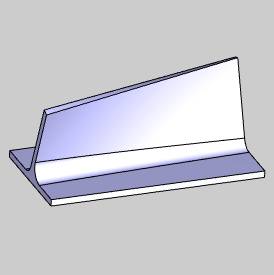
Part 1) Add the Feature
-
In the CAM Tree Manager, right-click
 Machine Setup and click Mill Multiaxis.
Machine Setup and click Mill Multiaxis. -
In the Multiaxis Wizard, select Swarf Machining.
-
Click Next>> to go to the Posting settings.
Part 2) Define the Posting Parameters
-
The Work Offset # is automatically set to the value defined in the Machine Setup.
You can change the value here to update the Work Offset # for the feature. -
Click Next>>to go to the Multiaxis Posting settings.
Part 3) Define the Multiaxis Posting Parameters
-
Notice, at the top of the dialog box, that the Use Machine Settings checkbox is selected.
This means that the Multiaxis Posting parameters for the feature use the same parameters as the machine that is selected in Current Settings.
You can clear the Use Machine Settings check box to define the Multiaxis Posting parameters of the feature separately from the current machine settings.
For this example, no changes are needed.
-
Click Next>> to go to the Tool settings.
Part 4) Define the Tool Parameters
-
In the Tool Data group, set the Diameterto 0.75 and set the Corner Radiusto 0.00 to automatically search and load a tool from the Tool Library.
-
Click Assign Tool Holder.
-
In the Milling Tool Holder Library, click to select 0.750 inch I.D. Arbor CAT 40, and click OK.
-
Click Next>>to go to the Parameters.
Part 5) Select Geometry
-
For this example, we are using the Automatic strategy because it always uses a Swarf Surface selection, and we also turn on the option to select the Upper Curve and Lower Curve geometry.
These options allow the system to find the best fit of the tool with the swarf surface and the upper and lower rail while allowing you to more easily define the cutting method (direction and side) as well as the ability to gouge check the Swarf Surfaces. -
Under Geometry Selection, next to Swarf Surfaces, click
 .
.
Select the swarf surface as shown next.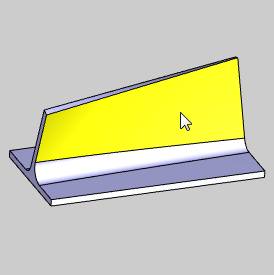
-
To confirm the selection, click OK.
-
Under Geometry Selection, click to select the Guide Curves check box.
-
Click Upper.
Select the upper curve as shown next.
(Be sure to select the surface edge and not the top surface.)
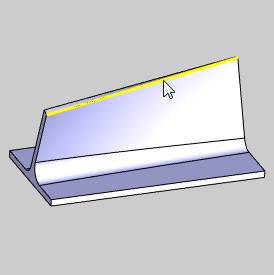
To confirm the selection, click OK.
-
Click Lower.
Select the lower curve as shown next.
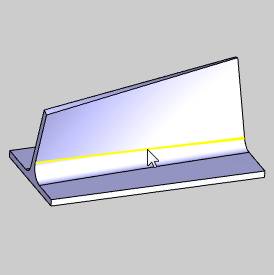
To confirm the selection, click OK.
Note: The geometry selections for swarf machining change depending on the Strategy selected.With any strategy, you have the option to select the Upper and Lower Curves which are used to align the tool.The curves are split into equal-length segments and the matching points for each segment are used to create the tool orientation.Selecting the Upper and Lower Curves gives you control of the cutting side and direction for the feature.If you don't select the curves when using the Automatic strategy, the system attempts to find the correct curves and cutting direction automatically using only the selected swarf surfaces.
Part 6) Define the Parameters and Create the Toolpath
-
To leave material for finishing, in the Swarf Clearance box, type 0.30.
In the Machining group, next to Side, select Left. -
At the top of the dialog, click Link.
-
Click Retracts.
In the Clearance Area group, confirm that the Type is set to Plane,and the Direction is Z Axis.
Confirm that the Heightis set to 4.000.
This value is automatically set (but only when the feature is created) using the Clearance Plane value from the Machine Setup.You can modify the Clearance Plane for the feature in this location at any time.
Click OK.
-
At the bottom of the wizard, click Compute.
The result is shown next.
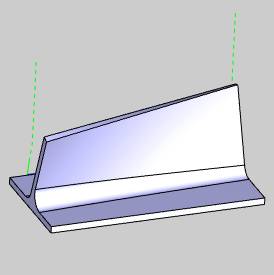
-
Notice that the toolpath computed on the wrong side of the part.
In the following steps, you change the Cutting Side to resolve this problem.You can also resolve this issue by reversing the chain direction of the Lower Edge curve.The steps to do this are listed at the end of the next section.
Part 7) Edit the Feature
-
To edit the feature, in the CAM Tree, right-click
 Feature Multiaxisand click Edit.
Feature Multiaxisand click Edit. -
On the left side of the Multiaxis Wizard, click Parameters.
In the Machining group, next to Side, click the down arrow and select Right. -
At the bottom of the dialog, click Compute.
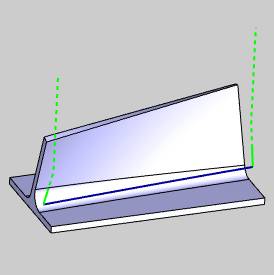
Tip: When selecting the Upper and Lower Curves, you can determine the Machining Side using the chain direction of the lower curve as explained next:
• To view the Start Point, in the CAM Tree,right-click ![]() Second/Lower Edge Curve and click Modify.(This is contained in the Geometry folder under the Multiaxis operation.)
Second/Lower Edge Curve and click Modify.(This is contained in the Geometry folder under the Multiaxis operation.)
• In the Workspace, the start point becomes visible.To change the start point, click near the end of the entity, and then click ![]() .
.
• In addition to the previous method, to reverse the direction, you can right-click ![]() Second/Lower Edge Curve, and click Reverse Direction.
Second/Lower Edge Curve, and click Reverse Direction.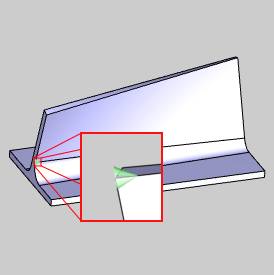
Part 8) Add Leads
Notice that the toolpath is plunging directly into the edge of the part geometry.This is not the desired result for this example.(To simulate the feature and review the result, right-click Milling Job and click Simulation.) Next, you add a lead-in and a lead-out to cause the tool to plunge outside of the part, so that the side of the tool is used to begin the cut.
-
In the CAM Tree, right-click
 Feature Multiaxis,and click Edit.
Feature Multiaxis,and click Edit.
On the left side, click Parameters.
Click the Link tab. -
In the Entry/Exitgroup, next to First Entry, (on the right side) select Use Lead-In.
Next to Use Lead-In, click ![]() to open the Lead-in dialog.
to open the Lead-in dialog.
Notice at the top of the dialog, that the ![]() Use Default Lead-In check box is selected.
Use Default Lead-In check box is selected.
Click OK.
-
In the Entry/Exit group, next to Last Exit, (on the right side) select Use Lead-Out.
-
At the bottom of the dialog, click Default Lead-In/Out.
In the Lead-In group, next to Type, select Tangential Line.
At the top of the dialog, next to Copy, click .
.
Click OK. -
Click Compute.
The result is shown next.
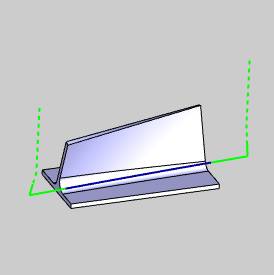
-
To view the result, in the Modulesmenu, click
 Simulation.
Simulation.
To learn more, view Getting Started with Simulation.
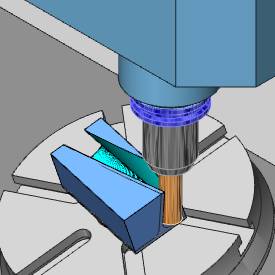
-
To close simulation, in the Modulesmenu, click
 Exit Simulation.
Exit Simulation.
Part 9) Create Multi Cuts
Now instead of cutting the part with a single slice, multiple slices are created using Multi Cuts.
-
Edit the feature, click Parameters,and click the Multi Cuts tab.
In the Pattern Slices group, in the Depth Stepsbox, type 4.(By Number of Slices is selected by default.)
Click Compute.
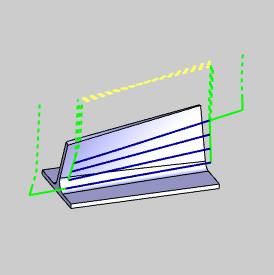
- Notice that the retract moves are again within the bounds of the part.(This is for all links that are not the first entry or the last exit.)
To change this result, edit the feature, and click the Linktab. - In the Links Between Slicegroup, next to Large Moves,select Use Lead-In/Out (on the right side).
- Click Compute.
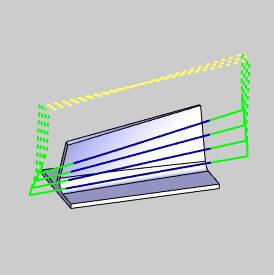
Now all depth steps use the same lead-in and lead-out as the first entry and last exit moves. - Simulate the feature again to view the changes.
New to Swarf, you can now define Extensions for the toolpath in addition to, or instead of using leads.You can define the length to extend the start and end of the toolpath separately or you can define a starting angle from the swarf surface for the start of the toolpath.This is shown at the end of this tutorial.
Part 10) Add a Gouge Check
There may be times when you want to use Swarf machining even though the machining surfaces are not truly flat.This could result in gouging the surface if the feature is defined too close to the target surface.In such a scenario, you can use a Swarf feature to get as close as possible to the target surface before applying a different strategy to finish the part.The Gouge Check can be used to push the tool out of swarf, or away from the target surface.This means that the tool is moved away from the surface by drawing a line between the contact points of the upper and lower rail; the tool is moved away at a right angle to this line.
-
Edit the Multiaxis feature, click Parameters,and click the Gouge Checktab.
-
In the Gouge and Excessgroup, next to Check,select Swarf Surfaces.
(You must have selected at least one Swarf surface to use this check.)
Confirm that the Degouge option is selected next to Collision Handling. -
If there are additional surfaces that you want to gouge check, you can select Additional Surfaces or Swarf and Additional Surfaces for the Gouge and Excess Check setting.(These same options are also available under the Avoid by Relinking and Avoid by Retracting groups.The names of these groups determine how the tool is moved to avoid gouges (relink or retract.)
-
After selecting any option that includes additional surfaces, the geometry selection button displays.Click
 , select the geometry to gouge check, and click
, select the geometry to gouge check, and click  .
.
This can be the part geometry or any other geometry. -
You can also define the amount of clearance for the tool holder in the Clearances group.
-
To update the feature toolpath, click Compute.
Part 11) Minimize Table Rotations
When creating Swarf features, there may be fast machine movements that can be minimized.The following option is provided to help reduce these movements.
-
Edit the Multiaxis feature, click Parameters,and click the Tool Axis Controltab.
-
Select the
 Minimize Rotation Axis Changes check box.
Minimize Rotation Axis Changes check box. -
To update the change, click Compute.
-
To view the result, on the Othertoolbar, click the
 (Simulation) icon.
(Simulation) icon.
For this example, the amount of machine movement, specifically the table rotation, is greatly reduced.
Part 12) Add Extensions to the Toolpath
-
Edit the feature and click Parameters.
-
At the bottom of the dialog, in the Extensions group, type 1.00in both the Start and End boxes.
This extends the lead-in and lead-out by the specified value.(You can use these options with or without leads defined for the feature.) -
Compute the toolpath.
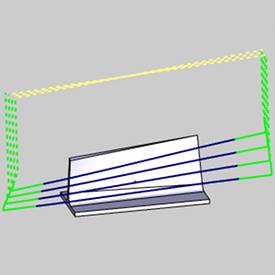
This concludes the tutorial.






